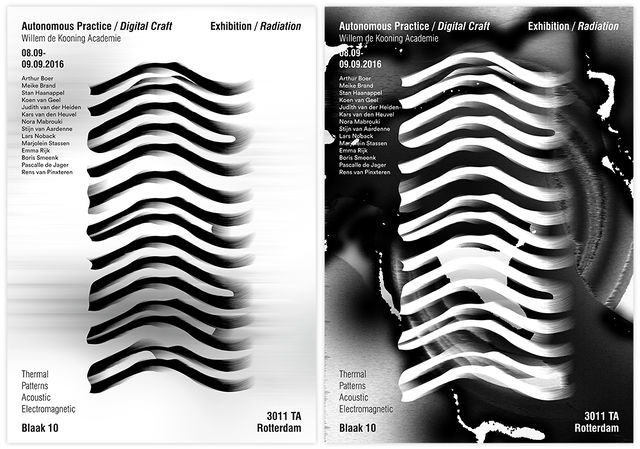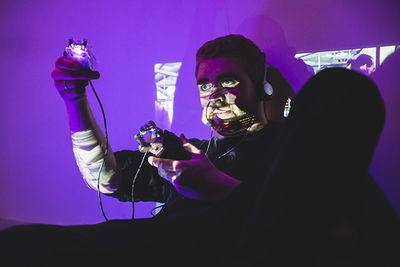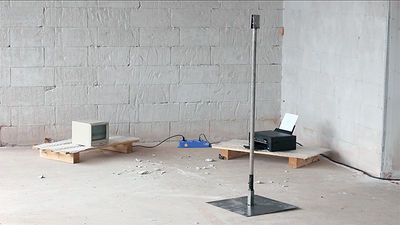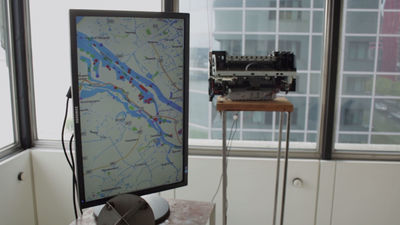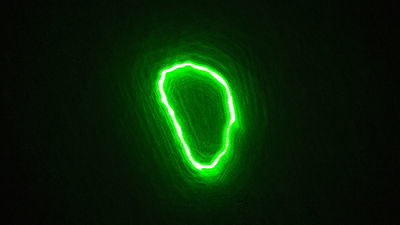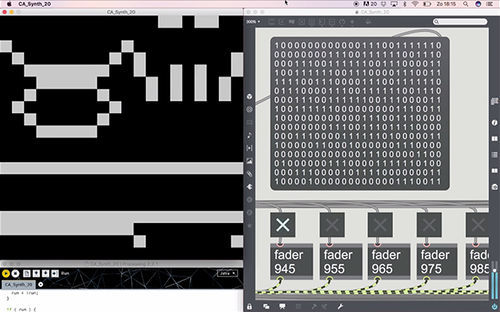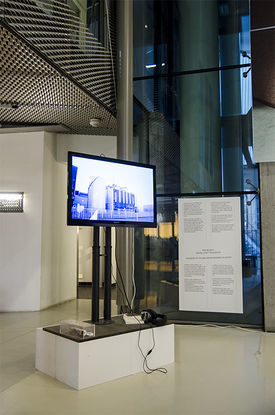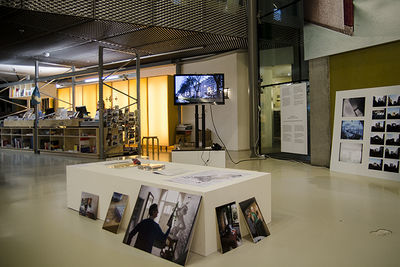User:Rensvanpinxteren/Research Paper
Contents
CRAFT AND RADIATION
Webpage
Research Paper
ABSTRACT In this paper I will talk about researching, exploring and experimenting with the multiple subjects and aspects within Craft and Radiation. Therefore I will challenge myself to discover new things by investigate phenomena and questioning theories within the digital realm. I also will reflect upon the position of my work and the relationship with craft and technology. Throughout the minor Digital Craft we had to explore several subjects within the context of radiation. The themes were electromagnetic, thermal, acoustic and patterns. With each theme we got a short introduction, a workshop and the ability to form a small group around a subject of interest. By then we had the opportunity to develop a work within a week or two. The intention of these short projects was to gather as much knowledge as possible about radiation and use this to create a final project. In my final work I focused on electromagnetic radiation and the way this is part of our everyday life. The project occurred out of my own fascination for the sound that this radiation produces. By building a sensor I was able to listen and collect these electromagnetic waves and this new ambient experience became part of my daily commute. With these radiating hums I made a composition that exposes the presence of electromagnetic radiation within our surroundings.
While the start of the last phase of my study approaches - the part where everything comes together - I look back on the minor Digital Craft. In this research document I look back on a period in which I learned a lot about the digital realm and how to cope with it. During this minor I got inspired by my fellow students and their passion for Digital Craft. I also got obsessed by several subjects and experienced how people on the outside react upon our works. My fellow students and I got to know ourselves better as artists and designers. Working with all these highly motivated people meant that we were able to get the best out of ourselves. This and the urge to learn as much as possible about the digital realm made the time working on the minor sizzling. Of course this period was not without difficulties, everybody had good and bad moments. But in the end the hard work was all worth it and we can we say, with pride, that we are true digital crafters.
After I finished the last phases of the traditional graphic design classes last year, gained enough knowledge out of the practices and had finished half of my dynamic internship, I knew what I wanted for a minor. I’ve always been someone who lives with the reality of today but focused on the future. After I graduate, I would like to profile myself as a multidisciplinary designer. I want to master as many techniques, methods and media during my studies at Willem de Kooning. This knowledge I will use to substantiate my work with a critical point of view. This is something I will always do. I can remember that Jon Stam said, during the introduction talk of practice in my second year: “At Digital Craft we only want the best students and I assure you that a lot of students will drop the practice.” This, and the urge to learn about technology and multimedia, motivated me to chose the minor Digital Craft.
Practise in relation with craft and technology
Nowadays we are so closely connected to technology that we can not imagine living without. The digital realm is not only domesticated into our personal and public spaces. Our working environment is also totally dependent upon the digital domain. All systems, networks and signals have an enormous influence on all areas of life. The digital culture and automation will also change the work of a designer. ‘Easy to use’ programs, ‘Tutorials’ and ‘Open Source’ are making it possible for anyone to create and develop professional products without the experience and the needs for this specific expertise. A lot of these new working methods and technologies will change the contemporary work culture. The amount of active working people will be modified and the context of our professional and personal spaces will be changed. I am convinced that the combination between human and artificial intelligence will define us this century.
Productivity will increase without the actual presence of humans and labor will be performed by algorithms and data structures. These systems will have learned to analyze and copy human behavior to simulate this in a more efficient, accurate and stable way. Therefore we have to make way and apply ourselves to the digital age. By connecting ourselves increasingly to the internet we will develop a new digital culture in which we will create personal and social areas with digital personalities and virtual characters. This new cyberspace will define our standards and values.
As a designer I like to philosophize on these topics and by speculating on existing technologies and phenomena I can visualize a mental image of what this world would look like. I guess this is one of the benefits I have as a visual storyteller. Nowadays, through the internet, we can see what happens at the other side of the world within a split second. This has a great impact on our daily lives and culture. By studying these phenomena and experimenting with the media I would like to understand and control the media and culture. With this experience I hope to apply the context in a responsible way and use it to increase the quality of my work.
I myself am not a very technical person and I know that I am not a developer or a programmer. But I am a visual storyteller and I use my work as a medium to debate. With this skill I would like to proclaim stories from the digital realm. Therefore I feel responsible to interact with the contemporary media and undiscovered areas. But to understand this I must first know how they originated and how they work. That’s why I wanted to orientate myself as a student within the digital domain. During this minor I discovered that while interacting with multimedia and technology, I had the possibility to explore these environments. I’ve been in contact with several dynamic digital materials which all had their own states and values. And I experienced how systems generate data and how you can communicate through signals. By constructing prototypes and artifacts, I not only obtained knowledge and experience. More importantly, I got an insight in how art and technology can come together: out of fascination, curiosity and the will to believe in something.
Experiments
SOUL OF THE MACHINE
Our daily object speak to us in many ways, but unfortunately our own bodies can not hear their many pings and purrs. By tuning into to the primary way in which our electronic devices communicate, one can say we get closer to the ‘soul’ of the machine.
During the first week of the minor we got a short introduction about the course and the themes we would focus on. We were divided into groups, each with its own theme. Along with Emma Rijk, Pascalle de Jager and Boris Smeenk we got assigned the theme Electromagnetic Radiation. This type of radiation is for instance being used in AM/FM Radio Broadcasting, Wi-Fi and Radar technology. Within a week we had to develop a project that would demonstrate our findings on EM radiation and exhibit this at the Red Apple, Rotterdam. Most of the time EM (Electro Magnetic) radiation is not perceptible to our human senses. While we were discussing our ideas around the subject, we came to the conclusion that we wanted to transmute EM radiation into a perceptible form.
PROCESS
While researching we discovered that cassette recorders using an EM sensor to read the magnetic tape of the cassette. We decided to buy a cassette recorder and search for the sensor to see if we could catch some radiation. We bought a Thomas DK-52 micro cassette recorder and disassemble it. We found the sensor and it worked pretty good actually. We started to explore the area and we discovered that each electronic device had a different magnetic field, with its own characteristic sound. This discovery was really exciting and we decided to continue with this.
To understand how the sensor was working Boris and I wanted to build our own. We found an open source instruction and started to construct the sensor which consisted inductors, resistors, transistors and an Op-amp chip. After we soldered all the components to the perfboard, we had our own EM sensor. The experience of exploring the electromagnetic realm with this device reminded us of a metal detector. This metaphor we used in the design of this instrument. We’ve learned one important lesson while we were working on the construction of the exhibition: sometimes you can appropriate an area, making your work more valuable. With this said, we have used the surroundings in our advantage by exhibiting work through the whole room. Because of this, the participants experienced the digital realm by exploring the surroundings within the exhibition space.
http://makezine.com/projects/weekend-project-sample-weird-sounds-electromagnetic-fields/
SHORT, LONG, SHORT
By hacking an ordinairy printer we were able to develop a self sophisticated communication system based on the AIS radar technology, used by shipping traffic. Because of the liniar movement we were able to translate binary mathematics into digital electronics. By appropriating the method of morse code these digital electronics could be translated into information and send messages by radio waves.
The start of the regular Digital Craft course started with the sub-theme Electromagnetic Radiation. During my previous project I already worked with this theme so I already had some experience with this subject. Arthur de Boer and I decided to work together and we started to investigate the topic separated so we could later put our research together and compare our findings and fascinations. My research was orientated on the way how electric signals travel and carry messages. I decided to immerse myself into how a surface reflects on an incoming signal and redirect it towards a receiving sensor as in radar reflection and sonar technology. Arthur researched a real-time automatic identification system (AIS) that uses electronic signals to navigate and communicate with ships.
While we were figuring out how to combine our findings into a work, I found a broken printer and started to dismantle it to check for parts we could use. When we uncovered the mechanism we discovered the track of the printhead and it’s linear movement. We attached an Arduino UNO to the 12V DC motor and run the machine. This gave us the idea to use the linear motion as a method to produce Morse code, the international prosign language to send telegraph, invented by Samuel F. B. Morse in 1836. This method we wanted to use to send information through radio waves by our antenna. To manage this, we had to think of ways which gave us the possibility to produce a binary signal.
We decided to develop a power circuit that could be connected and disconnected by attaching small copper plates of the printhead and the case of the printer. This would give us the opportunity to generate zeros and ones as signals. To get that done, we wrote a processing code which was controlled by the input of an API for https://www.marinetraffic.com/nl/ais. Every ship that entered or left the Port of Rotterdam received the radio message ‘hello’ or ‘goodbye’ by our hacked printer. Despite the fact that the radio waves were too weak to actually reach the AIS of a ship, it was interesting to follow the conversation of the printer. The experience that these machines were talking with each other, without human interference, simulated the idea of the Radio of Things.
PARAMETRIC ORBITS
A dot, a line, a circle, an oval, a parabola. These are the subsequent variables of the complex spectrum of Lissajous figures. By experimentation we discovered that we could visualize these geometric shapes by reflecting infrared light on a vibrating surface. We managed to control these figures by adding different parametric frequencies at the same time and depict the acoustic waves with an infrared laser. With this method we defined these acoustic patterns as distinctive figures within their own spectrum.
With the experiences of the past projects I began to develop a new method for my working process. I discovered that the process of experimenting helped me to locate new insights. Because of this reason I started this new project with the sub-theme Acoustic Radiation. Since we've had the same interests, Koen van Geel and I decided to work together.
Radiating light is electromagnetic radiation within a certain part of it’s spectrum. The light we see as humans is called visible light and is usually defined by wavelengths. This form of radiation is used in a lot modern technologies such as Compact Disc (CD) and Infrared Thermal Camera (IRT). During the process we decided to use light as a medium to experiment with. We wanted to use a single light source to craft visual patterns and analyze their behavior. Therefore we used a green 10 mW laser, a 400 Watt subwoofer and the internet.
We found an method by which we could draw curves and patterns with vibration. All we had to do was getting a tin can, a balloon, a small mirror and a rubber band. This accessible approach was a nice way to get started with. We stretched the balloon over the tin can and placed the small mirror to the surface. After that we attached the tin can to the membrane of the subwoofer and pointed the laser into the mirror. While we were experimenting with different sounds, tones and frequencies, the most various shapes appeared on the wall. This was an exciting experience, but we got the idea that the effect of this method was more than just the noise that we had produced. That is why we went on with experimenting and by a coincidence we did a great discovery.
While seeking for the limits of these forms, Koen accidentally dropped two different pitches at the same time and a spectacular geometric shape appeared. This was the key to our project because now we could control and analyze these forms. By getting these new parameters our method evolved into a tool to generate parametric forms. We gained a lot of experience with this new way of working and we mapped these parametric equations. While we were researching this phenomena, we discovered that the French physicist Jules Antoine Lissajous used a similar method that lead to the discovery of the Lissajous Figures. Later on, these figures were used as the fundament to visualize the calculations of signals by an oscilloscope, the measuring instrument for electrical engineering.
SYMPHONIA AUTOMATA
A cellular automaton is a deterministic algorithm based on the function of natural dendritic. By using a formula and convert the outcomes into binary, cells will become active or inactive through time. Active cells wil be able to generate in a two-dimensional rectangular grid and evolve into specified shapes. By connecting the cellular automaton to the music and multimedia software Max/MSP. I was able to develop a generative synthesizer and formulate the algorithm into a symphony of generative sounds.
This was the first project where I had the freedom to work for myself. The sub-theme of this period was Radiation Patterns and with this project I didn’t want to fall back in a common subject. While I was researching I got fascinated by swarm intelligence, this is a collective intelligence of a self-organized system. For example, think about the swarm behavior of ants and birds. They’re directing each other while exploring their environment by complying collective rules. In my opinion the most interesting part was that different objects can take various formations by a set of simple rules. Herein I’ve been inspired by the installation of the sculpture artist Zimoun. The way in which he manufactures huge mechanical installations out of everyday objects, I find astonishing.
In the first phase of my project I tried to collect the parts for building a couple of Kilobots. These are small robots who can propel in formation by using a 12V DC module and a light sensor. To figure out what kind of software I would need to control the Kilobots I contacted Nikolaus Correll, Assistant Professor of Computer Science and Electro Engineering from the University of Colorado. He gave me a weblink of their Github https://github.com/correlllab/cu-droplet where they collect all their research. He also gave me the address of his contact person in China where they manufacture their print boards. Unfortunately, it would take at least thirty days before the print boards were developed and shipped.
Because of this setback, I had to think of another way to realize my idea. After some research on DC motors I found out that the hard disk is using an IC 555 brushless DC motor to drive the disk. I decided to buy a stock of HDD’s and took the DC motor out. My aim was to spin twenty-five DC motors in formation, controlled by a system that I designed in Processing. This would make it able to activate the motors independently. Also this process didn’t work out because a lot of the DC motors where recessed in the case of the HDD. Besides that, I didn’t got the motor to spin with Processing. This was because of a safety protocol used by the hard disk that made sure that the disks didn’t run too fast when they were being used. Besides the fact that it would take a lot of time to realize this work, I would never be able to achieve the desired effect of letting the motors rotate in formation. That was why I decided to continue developing the Processing code where I was working on earlier.
The Processing code was based on a system called Cellular Automaton, a collection of cells on a grid that evolve through a discrete time, according to a set of rules. These cells can become active or inactive, based on the state of their neighbor cells while the rules iterate. Each cell in the grid got a binary value, while the were active they produced a one and while inactive a zero. While the rules repeat, the pattern generate and each cell gives a binary message to the root. These values were passed on to the audio and multimedia software called Max/MSP using a socket. In Max/MSP I developed a composition of objects. Each of these objects could generate a specific pitch when they got triggered. I connected the out coming values from the CA in Processing to the objects in Max/MSP, which now had the potential to produce sound while being triggered by the generating pattern. With this method I had designed an auditory system that visualized a symphony of a computer generated cellular automata.
Final Project
ELECTROSMOG
While commuting between cities, a radiating world passes us unnoticed. This radiation cannot be perceived by human senses directly, but nonetheless this is a fundamental part of our everyday life. By exposing this radiation with a sensor, the possibility arises to collect and compose these electromagnetic waves. While exploring this imperceptible environment, a relation between the ambient and the city scene emerges. This intimate experience leads to an audiovisual composition that exposes the presence of electromagnetic radiation within our surroundings.
With all the knowledge of the past few projects packed together, I was ready to begin with my final project. I started thinking on what I’ve learned and how I would like to apply this knowledge in a work. During the previous projects I worked with sound as a medium and I started to develop a affection for this material. Not only did I found the technology behind sound more and more interesting, also the way in which sound and image engage in balance when they meet each other, I found very poetic. While I was visualizing a mental image about how this would look like in a work, I decided to go with it and continue to use sound as a material.
During my previous research I got inspired by several artists who manufactured sound out of the digital realm. A while ago I came across the hybrid musician called NSDOS. He uses digital craft and interact with nature to distill sounds out of his surroundings. Hereby he produces environmental and electronic compositions. I do not only think that his processes are really inspiring for a digital crafter, I also find his performances and imagery really magical. The other artist how keeps me busy for a long time An other artist that inspires me since a long time ago is Ryoji Ikeda. A Japanese sound artist who uses computer generated data as an input for his compositions. An important factor in his work is that he uses hi-tech methods to visualize these data and translate these as enormous video installations. By this he can give the audience an overwhelming experience and leave a huge impression on them. This is something I always wanted to do and since I had the opportunity to make something great I wanted to take that chance.
While I was researching I found the book - Dataphonics - from Ryoji Ikeda, herein he explains how you can convert sine waves into binary compositions. This method challenged me to develop my own method to capture sine waves. I contacted Simon de Bakker with the question if he could explain me something about the mathematical formulas that were being used within this method. He explained that I needed to make a graph wherein I could calculate the amount of bits over a period of time in (10 ms). By this I could analyze a pitch in Hz per 0.001 ms. This graph would make it possible to visualize the progress of a sine wave in bits, which I could use to make a digital representation of (Hz) audio frequencies.
After I build the prototype which made it possible to investigate how these patterns were generated, I needed input. Therefore I required input with enough contrast to study the dynamics of the pattern. I started experimenting with generated pitches from Max/MSP and standard samples. But these didn’t had enough contrast so I questioned myself what the most interesting and most alternate sound was that I heard during the minor. By this I came back to the sound of electromagnetic radiation that we gathered during the first project of the minor. In total I collected more than 15 Gigabyte (GB) of EM recordings. The dynamics of these sounds worked great and by experimenting with these sounds I unconsciously went on with electromagnetic radiation.
When I went on building a tool to visualize sound into image, I took the time to question myself what I had tried to achieve with this work. This was the moment I realized that I couldn’t substantiate the reason why I wanted to visualize sound anymore. In the process of developing this tool I went to technical and I realized that I was just making a visualizer, something you also could do with Processing and didn’t proof anything. I was reinventing the wheel and I got stuck with the idea of developing a new method, but actually I was just walking in a circle. This was the moment I questioned my fellow students about their opinion upon my work. But the thing that got their attention was the violent sound of the electromagnetic radiation. This was the turning point in my project, because I decided to leave my work for what it was and explore the electromagnetic realm.
This was the turning point in my project, because I decided to leave my work for what it was and explore the electromagnetic realm. I ordered new components on the internet and I started thinking about ideas on how I wanted to make a project out of this. When I received the parts I immediately went soldering. I wanted to build a new and stable version of the EM sensor to go on a electromagnetic expedition in public space. I wanted to collect as much material as possible so I got a professional Zoom H6 Handheld Pro recorder. Armed with the my EM sensor, zoom and a headphone I went on a field expedition in the urban environment. The three days that followed I locked myself up between the electromagnetic fields studying their behavior.
While I was observing the dynamics on public transport, 3G transmission towers and data servers I realized that I experienced an exclusive happening of the city. By building a sensor I extended my senses and gave myself access to an invisible world that is constantly around us. This I took with me in the process of my final presentation.
To strengthen my work I decided to make moving images of the daily city life to capture the ambient. Therefore I contacted James van de Ende, who graduated with photography at the KABK. I asked him if he wanted to learn me some techniques and if he wanted to join me and shoot some videos. We went to Rotterdam and started shooting, he taught me how to look as a photographer and how I could anticipate on light. I had a list of several locations I wanted to capture including subway stations, factories and rooftops. That day we collected 40 GB of videos but after I edited it, I only had 4 minutes of video that I could use. The idea was to make a 12 minute film with different images of cities, so in order to realize this I needed to get more material. That is why I went filming for three more days with the knowledge I gained by shooting with James.
When I collected all my video and audio material, I started creating a composition. Hereby I used my experience I gained by studying the EM radiation in public space. To increase the sound and make it more impactful, I decided to approach Lesley Romano, a friend of mine, who graduated as audio engineer at the SEA Institute, Amsterdam. He taught me some techniques to increase the sound and make it feel more overwhelming. With this knowledge I started tuning the sounds and sync it with the moving images. After I edited all the material I manufactured a ambient movie of 12 minutes that exposed the electromagnetic environment of the city.
During this project I didn’t only learn how to use different materials and techniques to create a complete piece, but I also that I’m capable of adjusting my work when I recognize a more interesting point of view within my process to tell a story. This is something I will keep in mind and I think that this open approach could define my work as an artist and designer.
Graduation
APPROACH
While I’m reflecting on the projects I worked on during the minor, I notice that there is one thing that comes back in all my work. Exposing unnoticed worlds and phenomena. Not only do I think this is very interesting, I also think that this could be my feature as an artist. That is why I want to use this as a common thread in my graduation project. Recently I’ve read the books - Art After the Internet - from Omar Kholeif and - You do have something to hide - from Dimitri Tokmetzis en Maurits Martijn. These inspired me to deepen myself into privacy and cyberspace. As I mentioned before I’ve always been interested in culture and technology. These two concepts are extended into each other and form our contemporary view upon modern live. In the coming years we will become even more intertwined with internet and technology. We are living in interesting times and we are laying the foundations for a new digital culture better known as the Internet of Things.
Arriving in this era, we will increasingly connect to our personal, public and work area. These spaces will have access to our personal information to anticipate on our needs. Maybe this sounds a bit futuristic but companies like Google, Apple, Tesla, Adtech, Microsoft and Amazon design these environments for us at this moment. With this media we will develop an online culture which will provides us with an enormous amount of data. Only the price we pay is that cyberspace will have access to our personal data. What I want to discuss is that we need to be aware of the fact that our personal data has a value. If this data falls into the wrong hands you can suffer an unprecedented amount of personal damage. This is the reason I want to take my responsibility as a designer to make a statement. I will decide what my statement will be, after I have studied the subject.
To achieve my goals I will use my knowledge as a digital crafter and explore the domains of cyberspace and search for weak spots to collect data. I then want to monitor and map people and their activities. With this information I plan to confront them with the fact that you leak data while you are connected with a WiFi hotspot or an unsecured router. By using this method, I want to hijack information and learn about things I really am not supposed to know. I not only want to make a statement about our online behavior, I also want to activate people to change their online habits by shocking them with information that I intercepted. According to Esther Keymolen, a Belgian technology philosopher who promoted on online trust in 2016, one of the reasons we choose our online presence over our privacy is because we only experience the user level. According to Keymolen, we, as users, don’t experience how the technology works and what the consequences are. People are not aware of the fact that their data is being used by companies and that they are being spied by several parties while they are surfing on the web. “Thereby our confidence will never really be tested and will it be hard to judge if something can be really trusted,” Keymolen presumes. This is one of the reasons this subject interests me.
Unaware people are connecting and disconneting with public access points without being aware of there safety
Personally, I believe that with the rise of upcoming technology, it is fundamental to arm our modern digital culture with the fact that our data and personal information in valuable and that hijackers will try to seize this data. Therefore, I would assume the role as the designer of a hacker to see how far I can go and how people react. For this project I will develop a method that allows me to gather information. To map this content, I want to design a platform or format in which I can direct the information. How the process and my work eventually will look like will become apparent during the course of my project.
By making a work about the way we deal with information, I want to provoke reactions that confirm sensitive subjects within our digital culture. To realize this project, I will have to develop enough perseverance and decisiveness to make it able to claim this topic. Therefore I will develop a way of thinking to claim these topics. I may have to infiltrate into worlds that are so far unknown to me. So if I would define the profile of my graduating project, I would like to emphasize that I will work on a social project out of a autonomous vision within the digital realm.
Statement
“Graphic design is based on a history of concrete forms, while it is one of the tasks of the designer to interact with the media of the time. It must not relearn to read and write, but must cope with an ever-changing environment.”
We face a groundbreaking time in which technology will define our contemporary society. The methods to communicate an exchange information by the internet, will become increasingly complex. The programming language will take a central position in the world. Also, engineering and computer technology will be more accurate and more intelligent. To cope with these new technologies, as a designer, you at least will need to have some basic knowledge. For me it was important to experience how some of these technologies have been originated, how they affected the social context and what new innovations they have brought.
It was really useful to constantly look around yourself, and more important, to listen to your fellow students. During this minor motivation of us as a group stood central and we learned a lot of each other. I experienced how some of the students became real crafters by claiming their subject and master their methods. The methods I used also have defined my craft and made me to where I am right at this moment. I’m a remixer who analyze material and master it through appropriation and making new connections. By connecting pieces together, I compose new stories out of existing parts.
For me digital craft is not only an education on how to learn about art, electronics and technology, it is a mind state that gives you the ability to use the digital realm as a power to make new connections. In this way I got to know myself in a different way and I’ve discovered that I often use my work as a medium to debate. Because of this I’m willing to change work to tell my story.
